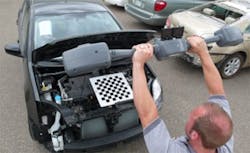3-D wand helps technicians effect auto repairs
Guidelight Business Solutions (Austin, TX, USA) has developed a 3-D vision system for Matrix Electronic Measuring (Salina, KS, USA) that delivers precise measurements of a vehicle's body and engine.
In use in a repair shop, the hand-held system called "The Wand" provides auto technicians with a complete picture of all the damage to a vehicle saving hours of labor lost when unforeseen damage is discovered after the repair process has begun.
After placing a checkerboard target on the area of interest on the vehicle, the Guidelight's Wand -- which sports dual viewfinders in its center and two cameras at each end – is used to take simultaneous pictures of it from two different perspectives, a process that takes about 30 seconds.
The images are downloaded to a PC, where software Guidelight developed as part of the system knits together the raw images to create a 3-D model of the vehicle. Next, the length, width and height between points on the image can be selected and measured. Those measurements can then be used to assess the extent of hidden damage to the body of the vehicle.
The images generated by the system can also be saved and used by the repair shop to share with its customers as well as insurance companies who need to verify the extent of damage to a vehicle.
After the software has been used to assist the user with the repair of a vehicle, the system can be deployed once more to check the quality of the repair that has been performed on it and the results printed out or emailed to a customer.
Recent articles on 3-D technologies from Vision Systems Design you might also find of interest.
1. Kinect API makes low-cost 3-D imaging systems attainable
Microsoft's Kinect is stirring up new interest in 3-D imaging due to its low cost and 'hack-ability' by novices and experts alike.
2. Software transforms images and video into 3-D
An engineer from the University of Illinois at Urbana-Champaign (Champaign, IL, USA) working with software developers at Microsoft Research has developed an algorithm that can automatically transform 2-D single images, as well as 2-D video sequences, into 3-D.
3. Kinect used to create 3-D death mask of Newton
Researchers at Microsoft Research Laboratory (Cambridge, UK) have used a Kinect camera to produce the first ever 3-D scan of Sir Isaac Newton's death mask.
4. Single moveable lens creates 3-D images
Researchers at the University of California-Los Angeles and Intelligent Optical Systems have developed a novel 3-D imaging system built around a moveable single lens.
Vision Systems Design magazine and e-newsletter subscriptions are free to qualified professionals. To subscribe, please complete the form here.
-- Dave Wilson, Senior Editor, Vision Systems Design
